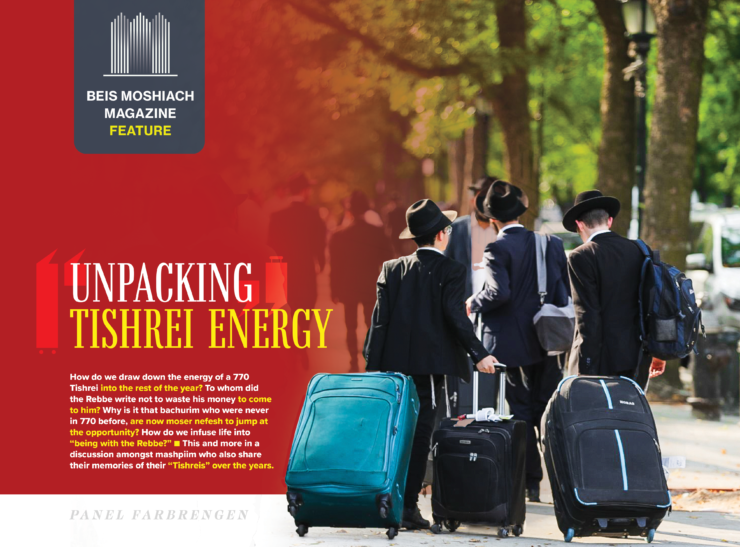Born & Bred In 770: Our Tishrei with the Rebbe — As Kids In Crown Heights (Part 2)
Rabbi Sholom Yaakov Chazan and Avrohom Rainitz farbreng with Rabbi Sholom Ber Brod, Rabbi Chaim Levi Goldstein, and Rabbi Yosef Reizes. There are Chassidim who saw the Rebbe for the first time when they went on Kevutza. There are Chassidim who saw the Rebbe for the first time a year or two after their bar mitzva when they went for Tishrei. There are Chassidim who saw the Rebbe at younger ages, when their parents took them along for a visit to the Rebbe. And there are Chassidim, like the three with whom we sat and farbrenged, who grew up with the Rebbe from when they were babies • Part two: Sukkos to Simchas Torah • By Beis Moshiach Magazine • Full Article
By Rabbi Sholom Yaakov Chazan, Beis Moshiach Magazine
To see part one, Click here
There are Chassidim who saw the Rebbe for the first time when they went on Kevutza. There are Chassidim who saw the Rebbe for the first time a year or two after their bar mitzva when they went for Tishrei. There are Chassidim who saw the Rebbe at younger ages, when their parents took them along for a visit to the Rebbe. And there are Chassidim, like the three with whom we sat and farbrenged, who grew up with the Rebbe from when they were babies.
For these Chassidim, the Rebbe’s presence, without pictures or videos, is an inseparable part of their childhood memories. Imagine that ever since you can remember, you’ve davened nearly every Shabbos with the Rebbe, you “hung around” at farbrengens from a very young age, and were regularly present at all the major events of the year. Nearly every childhood memory is associated, in some way or another, with Beis Chayeinu and the Rebbe.
When I asked them to farbreng together and tell their memories, they themselves didn’t appreciate the treasure they had stored away. “What can I tell you already?” asked one of them. Another one said, “I’ll come because you asked, but I’m letting you know that I may not have anything to say.”
After we said l’chaim and sat for nearly two hours, the memories began to flow. At the end of the farbrengen, when I thanked them, they said they need to thank me because the farbrengen together extracted memories that had been dormant for many decades.
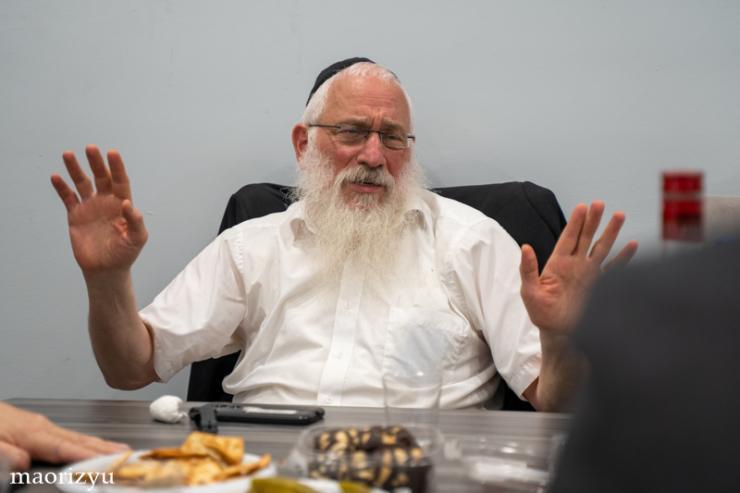


R’ Chaim Levi Goldstein
THE REBBE’S SUKKA – WHEN THE REBBE TRIED TO GET IN
Moving on to the Zman Simchaseinu, Sukkos. Let’s start with the building of the Rebbe’s sukka. Were you involved in that?
R’ Brod: In 5736 (1975), they built the Rebbe’s new sukka. Three bachurim were involved, my brother Yosef Yitzchok, R’ Avrohom Zaklikovsky, and R’ Shmuel Lipsker. They said that since the Rebbe is a king, they had to build him a royal sukka.
The entire sukka was made of waterproof wood that had previously been used to build top-quality ships and all the walls were made of one piece of wood that was cut into sections, which created a uniform appearance to all the walls. The double layered boards, filled with a special material, served to isolate fully against cold or heat. A special apparatus that they bought was meant to be attached to one of the walls of the sukka and to spread a tarp over the top when it would rain and the Rebbe wasn’t in the sukka.
Before they brought the sukka to the yard of 770, they had set up the necessary infrastructure for the water pipe and sink, electricity for the light fixture and the heating and cooling elements for the sukka.
I was involved in erecting the sukka and I remember that as I stood on a ladder holding a drill, the Rebbe suddenly left 770 and looked at me. That was a special moment.
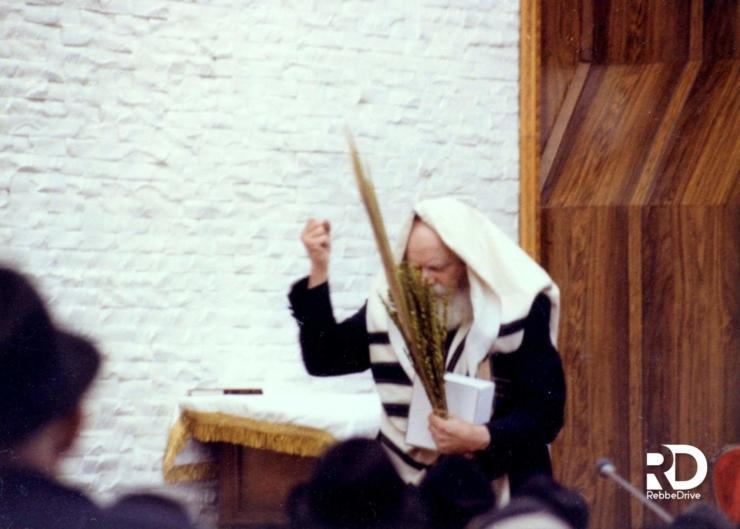


I’ll tell you something interesting. The organizers wanted to get permission to pour a cement base to support the sukka but they did not get permission to do so. The reason had to do with the concern that the Rebbe wouldn’t agree to enter such a magnificent sukka. The truth is that even the organizers were concerned but they realized they had to adopt the “l’chatchile ariber” approach.
That year, Succos 5736, it poured, starting from the beginning of Yom Tov through Shemini Atzeres, without a break! The water weighed down the sukka and since they hadn’t poured the cement support under the base of the sukka, the sukka began to sink into the thick mud created by the nonstop rain. The situation was that when the Rebbe wanted to enter the sukka, someone had to forcibly push the door open. When the Rebbe was inside, the door did not fully close.
One day, the Rebbe entered the sukka and after a while, R’ Meir Harlig noticed that the Rebbe was turning the doorknob in the attempt to open the door but the door had sunk a few inches in the mud and it didn’t open. R’ Harlig had to fight with the door to get it open.
Obviously, the following year, when they again asked to be allowed to pour the cement base they immediately received permission.
One year, I was zoche to bring a towel to the Rebbe in the sukka and after the Rebbe used it during Yom Tov and at kos shel bracha, I got it back. I had it for many years until one day, it disappeared.
R’ Goldstein: I don’t remember which year this took place but I was standing near the sukka for guests as the Rebbe left 770 on his way home. He first came over to the guests’ sukka, took a little bit of schach from the floor, threw it on the sukka and left.



R’ Yosef Reizes
DALET MINIM
Sukkos morning the Chassidim were able to say the bracha over the Rebbe’s dalet minim. In the early years the Rebbe was present in the sukka as Anash went by and said the bracha. Did you see this?
R’ Brod: In the middle of the chofs, the Rebbe had R’ Harlig stand there with the dalet minim and after that, R’ Harlig would go in with the Rebbe, receive the dalet minim, and let the Chassidim say the bracha over them.
Although I did not merit to say the bracha on the dalet minim near the Rebbe back then, as a child I stood and watched. Sometimes, the Rebbe sat with a sefer of the Rebbe Maharash and sometimes he stood behind the chair. Anash would go in and now and then the Rebbe would look at them. I said “back then,” because everyone got to say the bracha over the dalet minim on Succos 5752.
I stood on line from early morning and suddenly, I noticed that something special was going on. Within seconds, it became clear that the Rebbe had come to stand with the dalet minim. Afterward, we heard that when R’ Harlig came to take the dalet minim from the Rebbe’s sukka, the Rebbe stood as he held the dalet minim and asked: Where is the tzibbur saying the bracha? I want to see how the tzibbur says the bracha on the first day.
The Rebbe stood and watched each person like a father watching his children, each one individually.
R’ Reizes: Although the rumor spread and people standing on line already knew that the Rebbe was standing there, when the moment came to stand before the Rebbe, people became confused. I remember that I stammered as I said the brachos, from all the excitement.
FARBRENGENS IN THE SUKKA
Something else that you probably saw in your childhood, but eventually stopped, was the Rebbe’s farbrengen in the sukka. In 5730, one of the pyramids collapsed and the following year the Rebbe announced that he would stop farbrenging in the sukka because it was dangerous. What did you see and remember?
R’ Brod: At the end of the chofs, when the Rebbe entered the sukka it was so crowded that in order to open a path for the Rebbe, the Chassidim raised their arms upward, pushing themselves to either side. A sort of human tunnel was created between them which the Rebbe walked through. It was fascinating to see how, when the Rebbe arrived, the tunnel opened and the second after the Rebbe passed by, the tunnel collapsed and everyone was standing crowded together again.
One year, it was pouring and when the Rebbe wanted to leave the floor was full of water. The chevra took the benches from 770, placed them one next to the other so it would wide enough, and the Rebbe left the sukka like that.
R’ Reizes: We all remember the year that it rained throughout the farbrengen. The Rebbe came in to the farbrengen wearing a coat but as soon as he sat down, he took the coat off, as though it wasn’t raining.
R’ Goldstein: Not only did the Rebbe take off his coat, the Rebbe told some Chassidim to do the same. When someone came with a dry hat, the Rebbe asked: Where were you?
R’ Reizes: It wasn’t a storm like the strong rains in New York but it definitely was a steady rain which lasted from the beginning until the end of the farbrengen. The Rebbe sat there as though there was no rain and said a maamar, “U’She’avtem Mayim B’Sasson” which was appropriate …
After the farbrengen, when the Rebbe gave out kos shel bracha, you had to drink the wine right away because within a short time the cup filled with water.
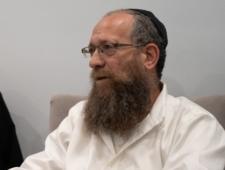


R’ Sholom Ber Brod
HAKAFOS – FROM THE ROOF…
Let’s jump straight into the hakafos of Shemini Atzeres and Simchas Torah. Detailed descriptions have already been written in many diaries over the years. I’d like you to tell us personal memories of Simchas Torah.
R’ Brod: I have a childhood memory of Simchas Torah. When we were children, hakafos took place in the shalash. At first, the roof was made of wooden beams covered with canvas. Often, when it rained a lot, the water would drip and create puddles and mud. At a later stage, they built a normal roof with a skylight that opened. As little children we loved to climb up to the roof and peek through the skylight.
I remember that once, on Simchas Torah, we opened the window and felt a blast of warmth rising from the Beis Medrash. Mischievous children threw little leaves and liked seeing how the leaf twirled, descending by force of gravity and rising up again because of the hot air, until one time, the leaf fell on the Rebbe’s sirtuk and all the children fled in a fright.
When the Rebbe farbrenged in the constructed shalash, there were plastic windows behind him and we loved sitting outside and seeing the farbrengen from the outside.
R’ Goldstein: Our parents brought us to the Rebbe’s farbrengens but as children we didn’t have the patience to sit the entire time. Shortly after a farbrengen began, we would go outside to play.
R’ Brod: Twice we would come back inside, once when the Rebbe asked that the children say l’chaim. R’ Michoel Teitelbaum, dean of Oholei Torah, would go out to call us: Kinderlach, the Rebbe wants you to say l’chaim. All the children would immediately run inside. When we said l’chaim the Rebbe looked at us with a broad smile. Then we would go back outside to play until the end of the farbrengen.
R’ Goldstein: When they began to sing the Alter Rebbe’s Dalet Bavos, we knew that after that they would sing, “Nye Zhuritze Chloptzi” and usually, the Rebbe would stand and dance in great joy, so the word would spread among the children, “They’re singing the Alter Rebbe’s niggun, and soon they’ll sing ‘Nye Zhuritze Chloptzi,’” and nobody wanted to miss this.
R’ Brod: During the years that the Rebbe danced alone at hakafos, at the first and seventh hakafa, he would go around with the Sefer Torah seven times. After we realized this, we knew when the hakafa was about to end.
Interestingly, this was also the case the night of Simchas Torah 5748. At the end of the seventh hakafa, the Rebbe did not put the Sefer Torah back in the aron kodesh but went up on his platform for davening which was a complete surprise and, with the Sefer Torah in his hand, began singing “Uforatzta.” He danced for a long time in tremendous joy. I noticed that at this “hakafa” too the Rebbe circled with the Sefer Torah seven times and then the hakafa ended.
R’ Goldstein: When our children were born, we brought them to hakafos. They were in the “ches” of the tables set up around the hakafos platform. Once, my oldest (Shneur Zalman) took a page of “Ata Horeisa”, folded it a few times and tried reach out with it to get to the Rebbe’s Sefer Torah to kiss it. He was unsuccessful and then the Rebbe stopped, took the page from him, touched the Sefer Torah with it, and gave it back to him for him to kiss.
R’ Brod: When the Rebbe danced with Rashag at the first and seventh hakafa, at the hakafos of the night of Shemini Atzeres, the Rebbe said the pesukim on his platform and went to the hakafa without his siddur. On Simchas Torah day though, since all the hakafos were done consecutively the Rebbe took the siddur with him and when he danced with Rashag he had R’ Leibel Bistritzky hold the siddur.
When I was a bachur, for a number of years when R’ Bistritzky also wanted to dance with the Sefer Torah, he let me hold the Rebbe’s siddur. I was in the “ches” and R’ Leibel came over to me and said: Sholom Ber, sit and hold this.
The moment the Rebbe finished the hakafa, R’ Leibel immediately came over to me, took the siddur and gave it to the Rebbe.
Another moment that I remember from one of the years in the “lameds” (seventies), when I was a bachur, I had a place outside of the “ches” facing east. On Simchas Torah day, after the davening was over, the Rebbe came into the “ches” and wanted to leave for his room but the tables that comprised the “ches” blocked him. Simchas Torah after shacharis was chaotic and people didn’t realize that the Rebbe was blocked by the tables. I was standing on the other side of the table and suddenly I saw the the Rebbe walking directly toward me. I didn’t have time to think of what to do as the Rebbe sat on the table, swung his legs from one side of the table to the other, and simply kept going.
R’ Reizes: I remember how on Simchas Torah 5734 (1973), the Rebbe began the niggun “HaAderes v’haEmuna” to the tune of the French national anthem. But first as an introduction – the night of Shemini Atzeres, in the middle of the hakafos, the Rebbe took the siddur and went to the edge of the platform. Everyone became quiet, to hear what the Rebbe would say and then the Rebbe began to say the pesukim of the fourth hakafa to the tune of the traditional “HaAderes v’haEmuna” which is also known as the “HaAderes v’haEmuna of Nevel.”
The Rebbe said a pasuk and everyone answered “l’chai olamim.” The Rebbe continued until he came to the end of the pesukim of the hakafa, saying the words “ne’imos b’yemincha netzach” very loudly.
The next day, the night of Simchas Torah, the scene was repeated when, in the middle of hakafos, the Rebbe went to the edge of the platform while holding his siddur, but then he began to sing “HaAderes v’haEmuna” in the tune of the La Marseillaise (the French anthem). At first, I didn’t know what kind of niggun this was, but then I saw that all those from France were enthusiastically joining in and I realized it’s their song.
R’ Goldstein: I immediately recognized the French tune since my father would sing it at home. Note: as far as I can remember, after the Rebbe sang the first stanza, he did not continue the high part without words, but continued to the next part of the niggun to the next words of “HaAderes v’haEmuna.”
R’ Reizes: Of all the decades that I had the zechus of being with the Rebbe for Simchas Torah, the most memorable hakafos for me were in 5738 when the Rebbe had a heart attack in the middle of hakafos. I was standing rather close and saw the goings-on.
I stood on the pyramid to the left of the aron kodesh, where the children were. I was the first on the row at table height and it was an excellent spot from which to see. I could see everything including the hakafos as well as what happened on the Rebbe’s platform.
From the start of the hakafos I noticed something odd. We were used to the Rebbe encouraging the singing with a special energy during the hakafos; it was electric. That year, the hakafos were more sedate. At the fourth hakafa, the Rebbe encouraged the singing with his hands but it was so weak that I didn’t understand what was going on. Obviously, nobody dreamed of a heart attack taking place but it was definitely odd.
Then, after a few seconds, the Rebbe turned toward the shtender and looked around for R’ Groner. When R’ Groner approached, the Rebbe said something and he rushed to give the Rebbe a chair. At that moment, we realized something was going on. All the years, the chair was in the corner and the Rebbe never sat in the middle of hakafos.
The Rebbe sat down and this was when everyone realized it was an emergency. There was a loud commotion in 770. The Rebbe sat and suddenly some doctors came over. In the background you could hear shouting that everyone should leave and within seconds they had broken the windows of the women’s section so fresh air could enter. After a few moments, the crowd of thousands who had been standing crowded together moments before, dispersed outside. Inside 770 there remained only about two hundred people. I could not get out during the initial moments and when I saw that the place was already fully air conditioned and my going out wouldn’t help, I stayed.
Although the Rebbe had had a heart attack, he was not willing to forgo the continuation of the hakafos. When it was the seventh hakafa, the Rebbe went to the platform for the traditional dance with Rashag. Usually, when Rashag danced with the Rebbe, you could see his utter bittul to the Rebbe. He danced at the Rebbe’s pace and the moment the Rebbe finished, he finished. He never tried to end the hakafa before the Rebbe stopped.
That Shemini Atzeres, after just three rounds, Rashag stopped and put down his hand. The Rebbe looked at him in surprise as though to say, “Why did you stop? Are you rushing anywhere?” but Rashag, who apparently had realized it was something to do with the heart or something similar, did not continue the hakafa and the Rebbe finished and went up to the platform.
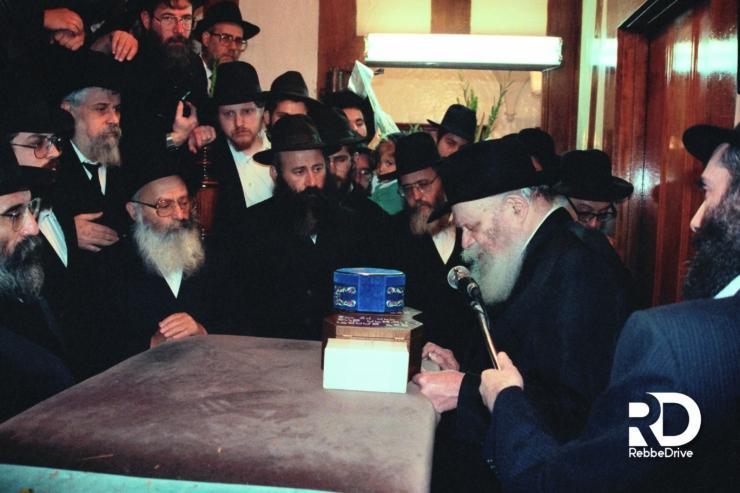


* * *
IN A YEAR, YOU’LL HAVE A SON
Rabbi Yosef Reizes relates:
My existence is thanks to a bracha from the Rebbe to my father. My father went to Beis Chayeinu in 5711 and the first farbrengen he attended was for 12-13 Tammuz. Unlike the farbrengen of 10 Shevat 5711, which occurred a few months prior and was attended by hundreds of people in the small zal, at this farbrengen there were only a few dozen Chassidim. They didn’t even bother to move the bima from its place in the center of the small zal.
After the farbrengen, on his way to his office, the Rebbe stopped near the bima and asked for a bottle of mashke and that all present should pass by him and receive mashke. When my father passed by, the Rebbe said: Next year you’ll have a son and name him for my father-in-law, the Rebbe [Rayatz].
On the one hand, my father was very happy to hear this promise, for several years had passed since he married and he had no children. On the other hand, the Rebbe’s telling him to name the baby for the Rebbe Rayatz made him nervous since his father was named Yitzchok and he was alive.
A few days later, he mustered the courage and went to the Rebbe’s room and asked the Rebbe for long life for his father. The Rebbe looked at him in astonishment and asked: Did something happen?
When my father said he was concerned since the Rebbe told him to name the baby for the Rebbe Rayatz, the Rebbe reassured him: You don’t need to give the full name; you can give part of the name, which one may do, just don’t combine it with other names.
A year later I was born and named “Yosef” for the Rebbe Rayatz.
Thank you for sharing your fascinating memories with Beis Moshiach readers. May we immediately merit the hisgalus of the Rebbe MH”M and all see the “seder ha’avoda” in Yerushalayim at the third Beis Ha’Mikdash!
*
The magazine can be obtained in stores around Crown Heights. To purchase a subscription, please go to: bmoshiach.org
246
Join ChabadInfo's News Roundup and alerts for the HOTTEST Chabad news and updates!









